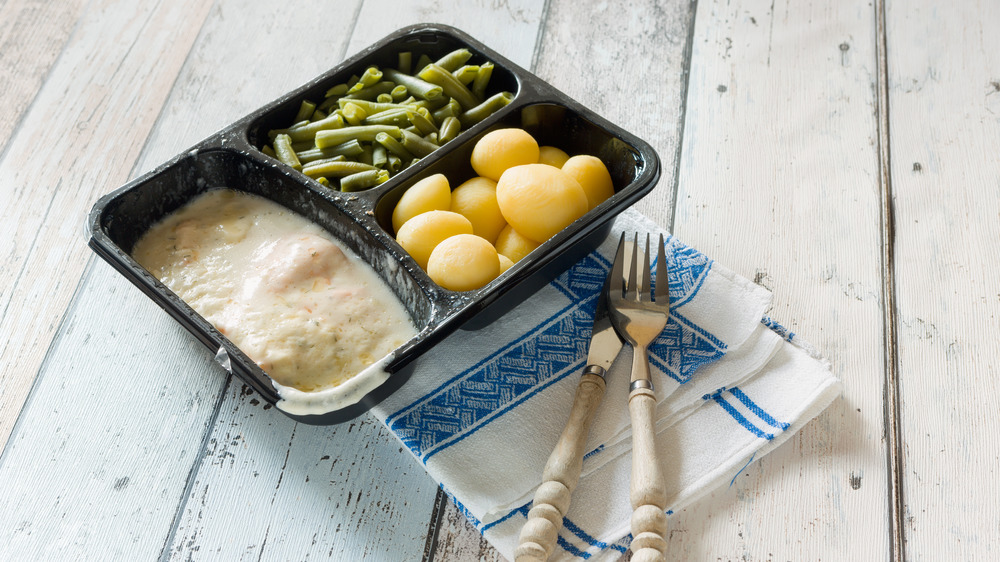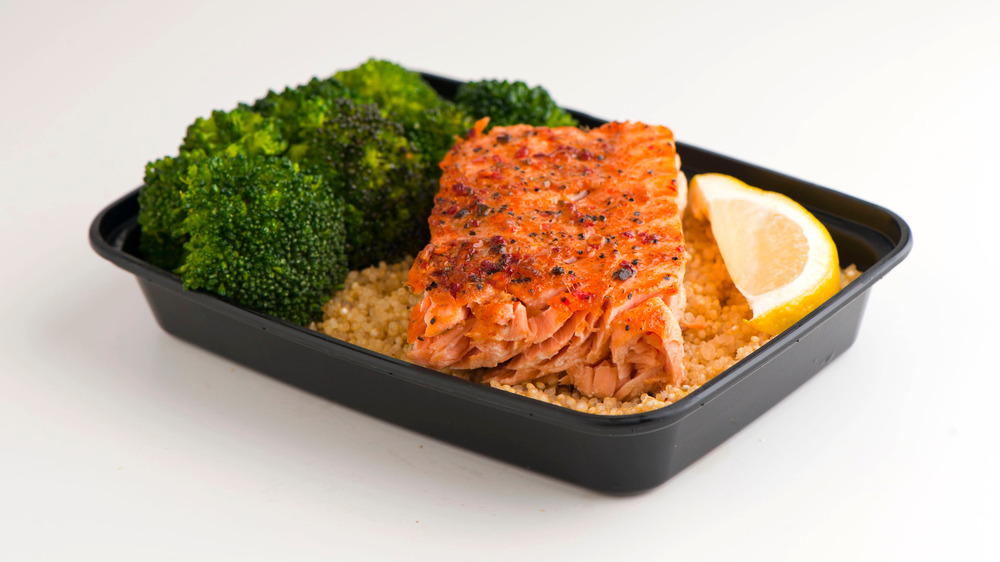This Is How Leftover Turkey Gave Us The TV Dinner
Thanksgiving leftovers can sometimes get boring. You can only eat so many turkey sandwiches. But it's thanks to leftover turkeys that we have the most convenient homemade meal ever: the TV dinner.
For decades now, the TV dinner has been saving lazy people who don't want to order in. Technically, the TV dinner is a colloquial term; these are really just frozen meals like what the grocery sign calls it. Swanson coined the term "TV dinner," and the company trademarked it to capitalize on the growing trend of people buying televisions and eating meals while watching. According to Smithsonian Magazine, a Swanson salesman named Gerry Thomas came up with the idea of marketing meals as TV dinners. Thomas realized in 1953 that Swanson had a surplus of frozen turkey — 260 tons of it, in fact, sitting inside refrigerated train cars. The company had no idea what to do with it.
Thomas thought it might be a good idea to recreate a Thanksgiving meal, so he added other holiday sides like cornbread stuffing and sweet potatoes to the frozen turkey. The food was to be served on aluminum trays so they could be reheated. Thomas worked with bacteriologist Betty Cronin to figure out how to kill off bacteria when reheating the meals. (Cronin claimed the frozen meal idea came from the Swanson brothers themselves.) The company released its newly marketed TV dinners and, in its first full year of production, sold 10 million boxes, said Daily Meal.
The idea had been around for a while
Swanson did not invent the frozen dinner. That honor goes to a company called Maxson Food Systems, wrote the Library of Congress. Maxson manufactured the earliest known frozen meal back in 1945. They called these meals "Strato-Plates" and designed them for reheating on military and civilian aircraft. These consisted of a meat dish, vegetables, and potatoes on a plastic plate. But Maxson wasn't able to market Strato-Plates to retail stores, especially after the death of its founder and for financial reasons. Most were sold to the Navy and various airlines.
The idea of frozen meals caught on, though. In the late 1940s, Jack Fisher's FridgiDinners came out, sold mainly to bars and taverns. Then came the Bernstein Brothers of Frozen Dinners Inc., who marketed the same product under their own label. These were only found in the Pittsburgh area, however. Even so, the company made 400,000 frozen meals by 1950. The brothers then started the Quaker State Food Corporation and sold over 2.5 million frozen dinners by 1954.
But it was Swanson's TV dinners that really took off. History Daily noted it was the result of a lot of savvy marketing on Swanson's part. Only 64 percent of Americans owned a TV by 1955, but Swanson hoped the sight of a television set was becoming familiar and added it to the package. Soon, people were snapping up TV dinners, even if food critics scoffed at them.
People miss the old frozen dinners
Back then, TV dinners were heated in the oven. The three-compartment aluminum tray was so iconic that when these were phased out, people waxed nostalgic about them. The next innovation in TV dinners was in 1986, when the Campbell Soup Company developed the microwavable tray. Of course, these days, most TV dinners are reheated via the microwave, and most people now relate the plastic trays with frozen meals.
Swanson, and other food companies, did not stick to turkey dinners alone, however. Much like today, they experimented with the meals they can freeze. Swanson even came out with something called a Polynesian dinner that Smithsonian Magazine described resembles nothing you'll see in Polynesia. Despite that unfortunate foray into island-ish reheating, Swanson became the undisputed king of TV dinners, especially since they sold TV dinners for 69 cents (they don't anymore).
This year, as you ponder your 13th turkey sandwich, say a silent thanks to leftovers for giving us the TV dinner as we know it. After all, you're probably still not in the mood to cook, and have been thinking of picking up a Lean Cuisine frozen dinner instead of trying to come up with yet another post-Thanksgiving dinner invention.


